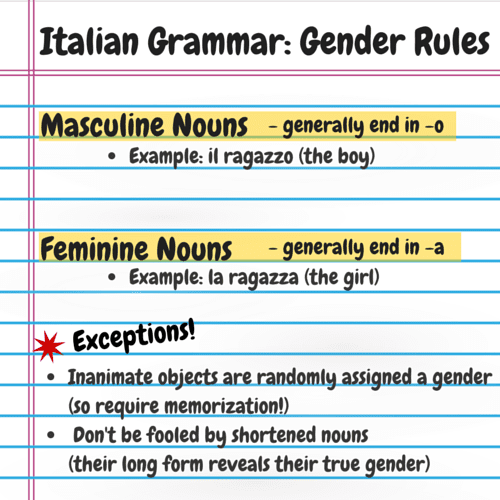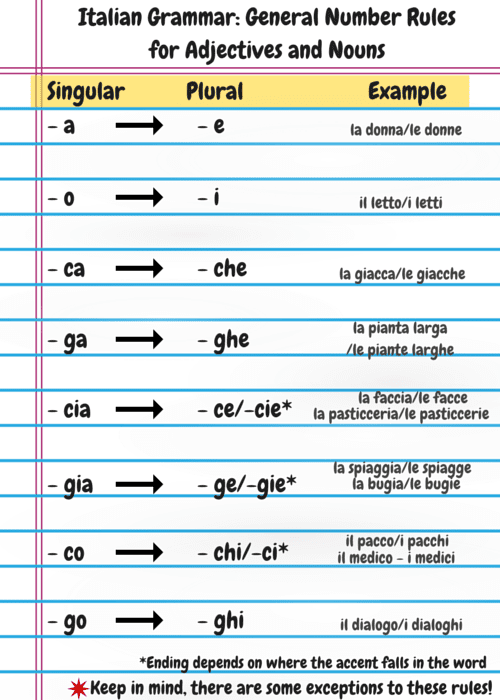When it comes to building a solid Italian grammar foundation, gender and number are two very important concepts one must learn. Unfortunately, they are also very troublesome for beginner students. Below Italian teacher, Nadia B. gives a quick and easy introduction to the two concepts…
Ready to explore Italian grammar?
For students, gender and number are often the most challenging concepts to understand, since they are used very differently in Italian than in English. However, with a little explanation and practice, you will be using them with ease in no time. So, let’s get started!
How is Italian Grammar Different From English?
Knowing how to understand Italian grammar in English isn’t that challenging, but there are a few differences to keep in mind.
- Italian allows for greater variations in word order
- Italian adjectives follow the noun, rather than precede it as is the case with English
- English is less of a phonetic language than Italian
- Italian pronunciation is generally easier than English
- The Italian language focuses on formal and informal language, while this isn’t usually the case for most English vocabulary
Understanding word gender is important for learning Italian, too. We’ll go into greater detail on this below. The basic concept of Italian grammar in relation to word gender is this – all Italian nouns must identify either as masculine or feminine and all related words must agree with that gender.
Therefore it is a good idea to try to learn all new words with their attached articles.
Here is a video that can break that concept down a bit more for you:
What Are the Grammar Rules in Italian?
Here are some basic Italian grammar rules to master before your next trip abroad.
Gender Italian Grammar Structure
In Italian, nouns and adjectives can be either masculine or feminine. Usually the gender of the noun can be identified by the ending. For example, if the noun ends in -o it’s generally masculine, and if the noun ends in -a, it is generally feminine. In the plural, nouns ending in -i are generally masculine, and nouns ending in -e are feminine. See examples below.
Masculine:
- il ragazzo (the boy) / i ragazzi (the boys)
- il libro (the book) / i libri (the books)
- l’albero (the tree) / gli alberi (the trees)
Feminine:
- la ragazza (the girl) / le ragazze (the girls)
- la penna (the pen) / le penne (the pens)
There are exceptions to the above-mentioned Italian grammar rule. For example, nouns that denote inanimate objects are randomly assigned a gender. It is best to continually practice these words in order to memorize them and their gender. See examples below.
- l’arte (the art) – feminine
- il bicchiere (the glass) – masculine
Also, don’t be fooled by nouns that are commonly shortened, as their long form reveals their true gender. See examples below.
- la bici=la bicicletta (the bicycle)
- la moto= la motocicletta (the motorcycle)
Feminine Nouns and Adjectives
Once you’ve learned how to identify whether a noun is masculine or feminine, another important component to learning Italian grammar is how number affects nouns.
When we pluralize a noun, it generally follows the rule that the -a ending in feminine singular nouns changes to -e, and the -o ending in masculine singular nouns changes to -i. The same applies to adjectives. See examples below.
- la donna (the woman) becomes le donne (the women)
- la città (the city) becomes le città (the cities)
- il letto (the bed) becomes i letti (the beds)
However, what happens when the ending is a little different to begin with? If it’s a feminine singular noun or adjective that ends in -ca or -ga, we want to preserve the hard sound, therefore, the plural then ends in -che or -ghe. See examples below:
- la giacca (the jacket) becomes le giacche (the jackets)
- la pianta larga (the wide sole) becomes le piante larghe (the wide soles)
Feminine singular nouns that end in -cia or -gia drop the -i in the plural and thus the ending becomes -ce or -ge. This is to preserve the same sound and syllabication that occurs in the singular. See examples below.
- la faccia (the face) becomes le facce (the faces)
- la spiaggia (the beach) becomes le spiagge (the beaches)
The only exception to this rule is in the case of la camicia (the shirt) which retains its -i in the plural le camicie (the shirts).
If the stress lands on the -i in the -cia or -gia ending, though, then the noun retains the -i in the plural, with the ending -cie or -gie. See examples below.
- la pasticceria (the pastry shop) becomes le pasticcerie (the pastry shops)
- la bugia (the lie) becomes le bugie (the lies)
Masculine Nouns and Adjectives
For masculine nouns and adjectives, the ones that end in -co turn to -chi or -ci in the plural. The identifying factor is the accentuation — if the stress is on the next-to-last syllable, the plural ending should be -chi. Nouns ending in -co that have the stress on the third-to-last syllable turn to -ci in the plural. See examples below.
- Il pacco (the package) becomes i pacchi (the packages)
- il cucciolo stanco (the tired puppy) becomes i cuccioli stanchi (the tired puppies)
There are a few exceptions, though, like words originally from Greek and other ones that simply don’t follow the rule.
Here are some common words that are exceptions:
- l’amico (the friend) becomes gli amici (the friends)
- il greco (the Greek) becomes i greci ( the Greeks)
One last ending that changes from singular to plural is that of masculine nouns and adjectives ending in -go. These nouns change to -ghi in the plural.
For example:
- Il dialogo (the dialogue) becomes i dialoghi (the dialogues)
- Il capello lungo (the individual strand of long hair) becomes i capelli lunghi ( the head of long hair)
The only exception to this rule is nouns that end in -go that stem from a longer ending of -ologo. This ending creates a plural ending of -ologi.
For example:
- Lo psicologo (the psychologist) becomes gli psicologi (the psychologists)
- Il radiologo (the radiologist) becomes i radiologi (the radiologists)
Resources to Help You Learn Italian Grammar and Vocabulary
There are all kinds of ways you can master Italian grammar rules.
Do an Italian grammar check with the following ideas:
- Take online Italian lessons with a class or by yourself
- Pick up an Italian grammar book and read it regularly
- Do Italian grammar exercises
- Practice Italian grammar and vocabulary with flashcards and mnemonic devices
- Play these Italian grammar games
Remember, taking Italian lessons with a native speaker is one of the best ways to master the language, so consider signing up for some online or in-person classes today.
Is Italian Grammar Hard?
While there are many different Italian grammar rules to remember, they are not as difficult to learn as they may seem. In fact, after seeing gender and number usage in context and using them yourself, you will soon be able to distinguish between all the possibilities.
Work closely with your Italian tutor to come up with some fun exercises for you to better learn these complex Italian grammar rules.
 Nadia B. teaches Italian in New York, NY. She graduated summa cum laude from New York University, with a double degree in Italian Language and Literature and Classical Music Performance. Learn more about Nadia here!
Nadia B. teaches Italian in New York, NY. She graduated summa cum laude from New York University, with a double degree in Italian Language and Literature and Classical Music Performance. Learn more about Nadia here!
Photo by Son of Groucho
Suzy S.



